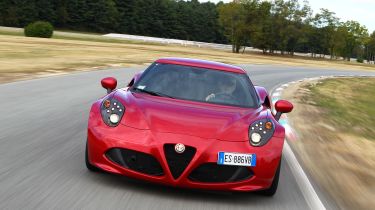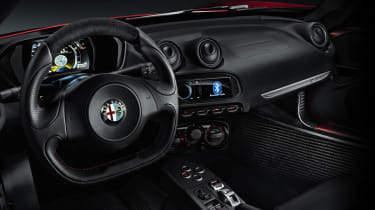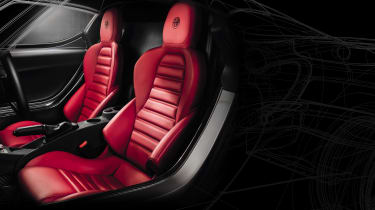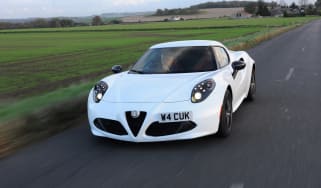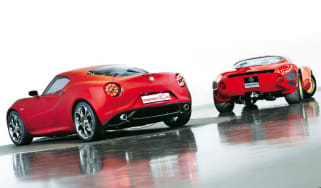Alfa Romeo 4C (2014-2019) review
We review the Alfa Romeo 4C, designed to deliver supercar thrills for half the price

The Alfa Romeo 4C caused a sensation when it was revealed in concept car guise at the Geneva show in 2011. The production version followed soon after, with exactly the same catwalk looks, while power came from a 237bhp version of the 1.75-litre four-cylinder turbo petrol engine found in the Giulietta Cloverleaf, mated to a six-speed TCT twin-clutch gearbox. In addition, Alfa introduced the 4C Spider in 2015 for added wind-in-the-hair thrills.
While the 4C's looks caused a sensation and marked a revival of the brand as a thoroughbred sports car manufacturer, the reality is that this Alfa doesn't deliver the kind of driver involvement and engagement that a pure-bred Italian sports car should serve.
There's a lack of powertrain and chassis refinement, and the car's performance is hampered by the slow-witted gearbox and laggy turbo power delivery, which the edgy chassis set-up struggles to cope with. That means the 4C is less fun to drive than similarly priced rivals such as the Porsche Cayman and Boxster, and Lotus Elise, while the car's edgy nature means it never feels settled, whether you're popping to the shops or cruising on the motorway.
Alfa Romeo's mainstream line-up is restricted to the ageing MiTo and Giulietta hatchbacks until the Giulia saloon arrives, but the 4C is something for fans of the brand to get excited about. It's a scaled-down supercar and features a mid-mounted 237bhp 1.75-litre turbocharged four-cylinder engine and a twin-clutch automatic gearbox. But as the coupe weighs less than 900kg, thanks to a carbon-fibre monocoque chassis, the engine delivers explosive performance.
Used - available now

2019 Ford
Fiesta
40,000 milesManualPetrol1.0L
Cash £9,999
2020 BMW
5 Series
60,000 milesAutomaticPetrol3.0L
Cash £25,499
2023 Mazda
2
19,177 milesManualPetrol1.5L
Cash £15,750
2019 Ford
Kuga
70,725 milesManualDiesel2.0L
Cash £11,859Alfa Romeo has a long history of sporting models, dating all the way back to the A.L.F.A. 24hp that competed in the 1911 Targa Florio race. With decades of Grand Prix, F1, Touring Car races and rallies under its belt since then, the firm seemed to lose is mojo in recent years.
Enthusiasts pined for the excitement and glamour of cars like the 1966 Alfa Spider sports car – a car so loved, that amazingly it survived in production right through until the early 1990s. The 4C is part of the Fiat group’s plan to bring that old Alfa magic back.
The 4C coupe went into production in 2013, but first arrived in the UK in 2014 while the 4C Spider followed a year later. Both versions are built at the Maserati plant in Modena, Italy.
Both models are built around a carbon-fibre tub with front and rear subframes in aluminium designed to keep weight down, although the Spider weighs in at 940kg, 45kg moe than the coupe, thanks to extra chassis strengthening to cope with the removal of the roof. Both cars feature composite moulded body sections made from glass-fibre reinforced plastic for low weight, strength and cost-efficient production.
Rivals to the Alfa 4C include the Porsche Cayman and Boxster, the Audi TTS and Lotus Elise.
Engines, performance and drive
From the moment you clamber across the thick sill and slide into the driving seat, you’re aware that the 4C is designed as a proper drivers' car. You sit low and forward in the chassis, the pedals are perfectly placed and there’s a wide range of steering wheel adjustment.
The racing car-style monocoque chassis weighs just 65kg, and the coupe tips the scales at only 895kg without fuel and passengers on board. The Spider is marginally heavier at 940kg, but that's hardly bloated. Alfa has even reduced the thickness of the glass by 15 per cent to shave off precious kilos. In context, the Alfa takes a very different approach to the civilised Porsche Cayman which is its most prominent rival – it has more in common with the stripped back Lotus Elise.
For £3,000 you can buy a Racing Pack, which adds sports suspension (including revised damping and springs, plus thicker anti-roll bars), as well as a fruity sounding sports exhaust and 18-inch front and 19-inch rear wheels. However, we'd stick with the standard chassis and smaller wheels, which make the driving experience a touch more civilised.
However you spec the car, the end result is a hard and raw driving experience. At idle, the exhaust sounds very purposeful, like a sixties racing Alfa, but on the move, there’s so much engine and road noise that long journeys are punishing – you can forget the radio, although Alfa does fit the 4C with a pretty puny Alpine aftermarket stereo. The unrelentingly firm ride quality becomes quite tiring, too.
The 4C’s unassisted steering is also a mixed bag. While it’s heavy at parking speeds, the weighting is fine on the move, and the rack is fast enough for rapid and accurate turn-in. But it doesn’t deliver the undiluted feel you’d expect. In fact, there’s little sense of what the front end is doing.
What you do get is plenty of unpleasant kickback as the wheel fights and wriggles in your hands. On bumpy and cambered roads the overactive steering and stiff suspension make the Alfa dart around, keeping you on the alert to maintain a forward heading as the car constanly bucks and dives for the edge of the road.
The 4C is a proper sports car – there’s no body roll, plenty of grip, serious performance and lots of character. But it’s too hard-edged for realistic everyday use and never offers the fingertip feel, adjustability and composure you find in a Porsche.
Engines
There’s only one powerplant available in the 4C, but as a result of the car’s low weight that 237bhp 1.75-litre aluminium turbocharged engine has enough oomph to push the 4C coupe from 0-62mph in 4.5 seconds. That’s extremely rapid off the line - and can be fully exploited using the car's launch control function. The Alfa also has 350Nm at 2,200rpm so in-gear pace is plentiful as well.
However, the engine's power delivery is quite spiky with plenty of turbo lag. Press the accelerator, and you have to wait a few moments for the turbo to spool up and send a sudden surge of power to the rear wheels. Combine this with the twitchy steering, and again it makes the 4C tricky to drive smoothly.
At least traction is good, and while the TCT dual-clutch gearbox needs delibrate prods from the steering wheel-mounted paddles, there’s a delicious rasp from the exhaust on every upshift. The brakes have a firm pedal, but are more than up to the task, although there’s little feel and the ABS cuts in too eagerly.
MPG, CO2 and Running Costs
With a price tag of £51,500 the 4C coupe is around £2,000 more than a Cayman S, while the 4C Spider carries an £8,000 premium over the coupe. That's a pretty big step when you consider the Porsche 718 Boxster S is only about £1,000 more than a Cayman S. It also means the Alfa 4C is pricier than a lot of accomplished rivals, such as the Lotus Elise, the aforementioned Porsches and models such as the Jaguar F-Type V6 and the entire Caterham Seven range.
Emissions of 157g/km are superb for a 160mph sports car, and make the Alfa a cost-effective choice for company-car drivers. It’s the result of low overall weight and a small four-cylinder engine, and it means that a higher-band earner will pay just £4,119 a year in company car tax – £644 less than for a manual Porsche Cayman.
Road tax will be a very reasonable £175. Alfa hasn’t confirmed servicing costs, but while only eleven specialist retailers will be able to sell you a 4C, all 46 UK dealers are able to service it.
Accident repairs could be a different story, as the carbon tub and aluminium space frames will be potentially very expensive to fix after a major incident.
As far as day-to-day running costs are concerned, the official claim for the 4C’s combined cycle fuel efficiency is 41.5mpg, with economy of up to 56.5mpg on a run out of town. You’d be hard-pressed to drive the red-blooded Alfa with a light foot though, so matching those figures in the real world seems highly unlikely.
Still, ignoring test-track driving, we averaged a fairly decent 30.8mpg fuel economy, so your petrol bills shouldn’t be too high. With a reasonable 40 litre tank it also means you’ll be able to cover 250 miles between fill-ups quite comfortably.
Insurance groups
Thanks to its relatively exotic construction, high purchase price and sporting performance, the Alfa 4C falls into the top Group 50 insurance bracket, which is well ahead of the Porsche Cayman in Group 41.
Depreciation
Given the entire 2014 UK allocation of 200 4Cs sold out very quickly, demand for the 4C should outstrip supply, so residual values should be decently strong.
Our experts predict a used price after three years/30,000 miles of just under 50 per cent. A Porsche Cayman is likely to be stronger still though, retaining a little more than half its value over the same period and mileage.
To get an accurate valuation on a specific model check out our free car valuation tool...
Interior, design and technology
Alfa Romeo’s back catalogue is full of pretty cars, and the 4C has the instant desirability to rival the best of them. Composite bodywork is wrapped tightly around a carbon-fibre chassis, and the proportions are straight from the supercar textbook. Yet at less than four metres long, the 4C is smaller than you’d expect, and its low and compact shape is more Lotus Elise than Ferrari 488. The taut rear end takes its inspiration from the late sixties 33 Stradale, while the angular nose recalls the recent 8C supercar.
It’s not all good news, though. For instance, the lines at the front end are spoiled by the awkwardly placed number plate, while the coupe's multi-bulb LED headlamps have come in for criticism. This has been remedied on the newer Spider model which features more elegant xenon lights, although the LED set-up is still available as an option. The Spider also features an exclusive yellow paint option, while the black fabric roof is opened manually.
Inside, the simple dash is angled towards the driver, but cheap plastics and borrowed Fiat switchgear mean the car lacks the upmarket premium feel that you'll find in a Porsche Cayman. The bare carbon weave in the footwells and on the high sills reminds you that you’re driving something special, while conventional dials are replaced by a TFT screen that perfectly displays revs, speed, gear position and trip information.
Elsewhere, leather door pulls, aluminium pedals and a flat-bottom wheel create a sense of occasion to match the flamboyant exterior. Leather seats, cruise control and floor mats are optional, but air-conditioning is a no-cost option. However, it's disappointing to find some exposed wiring in the cabin, which isn't really becoming of a £50k sports car.
The 4C coupe comes in black, grey, white, pearl white and two shades of red – Rosso Alfa and Rosso Competizione - while the Spider is also available in bright yellow at extra cost.
Interior trim options include black fabric with red stitching, red or black leather, or a fabric/leather mix. You can also add black alloy wheels and carbon fibre detailing to the exterior, although it all comes at extra cost.
Sat-nav, stereo and infotainment
The Alfa product planners want you to know the 4C was made for pure driving passion, so it doesn’t come with a radio as standard. There’s provision to fit one though, and a stereo with web apps, voice recognition and hands-free phone connection can be selected free of charge from the options list. However, the aftermarket unit looks pretty cheap in the cabin, and is a stark contrast to the TFT dials ahead of the driver.
Practicality, comfort and boot space
With a tiny boot, poor rear visibility, noisy cabin and stiff ride, the 4C won’t be bought for practicality. The standard exhaust and suspension with the 17 and 18-inch alloy wheel combination might improve comfort marginally, but there’s still no escaping the limited luggage space – you don’t even get a glovebox.
Dimensions and size
At 3,990mm long the Alfa 4C looks diminutive in profile and will slot into the smallest parking spaces. The Porsche Cayman is 4,380mm long. The Alfa gives away that advantage when it comes to width - at 1,868mm it’s broader than the 1,801mm Cayman, although both are well-proportioned for the average British B road.
Leg room, head room & passenger space
Even getting into the Alfa 4C is a challenge, as the door opening is small and the sill wide, like a Lotus Elise. Once inside the space is tight too, particularly for taller drivers who are likely to find their knees splayed uncomfortably. Headroom is an issue for taller drivers who’ll need to hunker down to see under the windscreen top rail, and the low-set seats are uncomfortably upright with little lumbar support. Backache might be the price you pay for them looking so stylish!
Opting for the Spider eliminates some of the access issues, as with the roof off you can step into the car much more easily, but then you have to remove the roof in the first place, which is a fiddly and time-consuming affair - there's no one-touch power assistance here, just flimsy levers and fiddly press studs to deal with.
Boot space
Whereas Porsche Cayman owners and their partner can happily set off for a weekend away with all their luggage stowed in the 275-litre rear and 150-litre front compartments, Alfa 4C owners will be standing on the pavement scratching their heads.
For starters, the front end doesn't feature any storage at all. The bonnet panel is fixed in place and cannot be opened without using tools. In the back, there's a small 110 litres space just behind the engine bay, so the car’s boot has room for little more than a couple of small bags. As the compartment is next to the engine you’ll need to watch out if you don’t want your shopping heated up, too.
If you’re driving the 4C Spider, you need the boot to store the rolled-up removable roof.
Reliability and Safety
Alfa has never had an outstanding reputation for durability, although its latest models have proved more durable than past eforts. The 4C is built by Maserati (which like Alfa Romeo is part of the Fiat Group) – although that's no guarantee that the coupe will be any more durable than the rest of the range.
On the plus side, the 4C’s 1.7-litre engine and TCT twin-clutch gearbox are developments of existing technology so they should be relatively trouble-free. It’s also a plus-point that this Alfa’s basic, almost track-focused spec means there’s little in the way of complicated electronic systems to go wrong.
If you do run into trouble, the Alfa Romeo dealership network was ranked 16th out of 31 by Auto Express readers in the 2015 Driver Power Survey – a solid ‘mid-table’ finish.
The remarkably low kerbweight places less stress on things like brakes and tyres, and the racing car-style carbon-fibre body tub is a big plus for crash safety – although any damage to it will be difficult and costly to repair. In spite of the swoopy exotic looks, the moulded plastic body-panels should be tough and resilient too.
Talking of crash safety, the Alfa 4C is sold in such low volumes that it hasn’t been independently tested by EuroNCAP – but the same caveat applies to the Porsche Cayman and most cars in the sector.
The Alfa’s safety features are relatively simple but include stability control, driver and passenger airbags and a tyre pressure monitoring system, and that carbon body tub should provide a high level of structural rigidity in the unfortunate event of an impact.
Warranty
The Alfa 4C comes with a three-year, unlimited mileage warranty, which matches the cover on the Porsche Cayman. Lotus offers similar cover on the Elise, Exige and Evora.
Servicing
If it was just down to oil and filter changes, the 4C’s servicing regime would be pretty cheap. The fly in the ointment is a requirement to inspect/check the torque settings of all the bolts holding the subframes and body to the car’s carbon tub. Alfa says it needs to be done at 12, 36 and 60 months – or 12,000, 36,000 or 60,000 miles - and the process will add several hundred pounds to the service bill.
